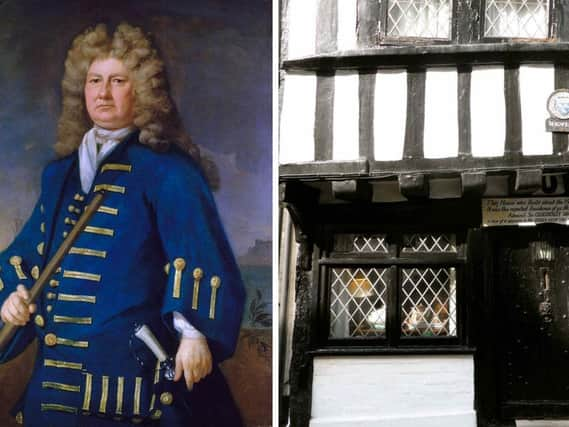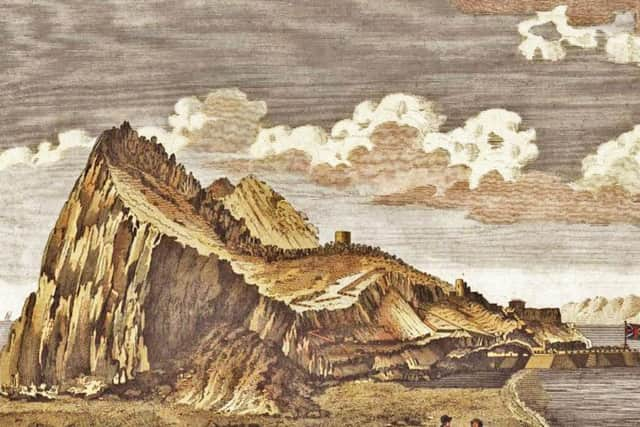Admiral who took Gibraltar died in shipwreck tragedy


Sir Cloudesley Shovell also had a strong Sussex connection in that his widowed mother came to live in Hastings in a half-timbered Tudor house that still stands. The Admiral visited her there. A popular local rock band has adopted his nomenclature.
Shovell was born into a prosperous Norfolk family in 1650. Aged 13 he went to sea as a cabin boy under the tutelage of a relative, Admiral Sir Christopher Myngs. By 1673 he was a lieutenant and had seen action in the Third Anglo-Dutch War in which the English were allied with the French.
Advertisement
Hide AdAdvertisement
Hide AdIn 1675 he participated in two successful attacks on a troublesome corsair base in Tripoli on the North African coast. Secretary to the Admiralty Samuel Pepys wrote to Shovell to confirm the award of a gold medal and a commendation from King Charles II.


By 1677 Shovell was a captain engaged in defending Tangiers from Barbary Coast pirates. Tangiers was in English hands from 1662 to 1684. At Bantry Bay in May 1689 he repelled a French attempt to seize the south of Ireland. King William III rewarded Shovell with a knighthood.
Alliances often shifted; the French were now England’s enemy and the Dutch were our friends. Off Tourville in 1692 Shovell beat back a French threat to invade Sussex. There were reverses; in 1693 he was part commander of an Anglo-Dutch force escorting 200 merchantmen to the Med when around 90 ships were lost off Lagos Bay, Portugal, in an action described as England’s worst disaster since the Great Fire of London in 1666. Shovell survived the debacle with his reputation intact and was actually promoted again the very next year to lead raids on Dieppe and Dunkirk.
Naval service notwithstanding, Shovell also sought public office, becoming MP for Rochester in 1695 and Commissioner of the Sewers for a stretch of the banks of the Thames. A pub near London’s Charing Cross rejoices in the name “Ship and Shovell”!
Advertisement
Hide AdAdvertisement
Hide AdIn 1702 he captured a host of enemy warships at Vigo during the War of the Spanish Succession. Shovell also commanded a squadron that occupied Gibraltar in August 1704.


Promoted to Admiral of the Fleet in 1705, his lofty rank didn’t end his active service. That same year he captured Barcelona and in 1707 led an attack on Toulon, France’s biggest Mediterranean naval base. When the French scuttled their fleet it signalled even greater glory for Admiral Sir Cloudesley Shovell. But little did he know that Toulon was high tide in his illustrious career. Indeed, it was high tide in his life.
Returning home that October, Shovell’s ships approached the Scilly Isles. The weather was good but a maritime disaster was brewing. The story has it that a seaman familiar with the islands saw that the convoy’s course would take them dangerously close to a partly submerged reef of jagged rocks. Nervously the sailor approached an officer and told him of his fears. The officer sent the man away.
The sailor later returned to his superior and again pleaded for a change of course. This time the officer relayed the story to Admiral Cloudesley but in doing so described the sailor as a troublemaker who was sowing unrest among the crew. The Admiral ordered the man’s summary execution.
Advertisement
Hide AdAdvertisement
Hide AdThe doomed sailor, his arms bound, was led to the yardarm. “Hang me and ye shall all drown!” he cried to no avail. The victim’s lifeless body was placed in a sheet of old canvas along with a heavy weight attached to his feet. The canvas was then sewn up. There were no prayers offered as the grim package slid down a plank and splashed into the sea.
No sooner had the deed been done than a strengthening breeze sprang up and banks of ominous clouds appeared. Some claimed that the hanged man’s body somehow escaped the canvas coffin and bobbed to the surface in the wake of the ship.
“The Association” sailed obliviously onwards until it plowed into the hidden Gilston Rocks. Her bottom was ripped out by a fearsome array of jagged granite teeth. The ship sank within minutes; eight hundred crewmen drowned along with Admiral Sir Cloudesley Shovell and his two young stepsons. Three other ships followed “The Association” to disaster. In all nearly 1,500 men perished.
Sir Cloudesley Shovell’s body was washed ashore. Rumour had it he was found alive but unconscious by a peasant woman. She was on no mission of mercy but was intent on robbing the dead of whatever valuables they might have. Grasping a knife she stabbed the helpless Admiral to death and then searched his body for booty. In time his remains were recovered from their rudimentary grave and taken to London for a dignified reburial in Westminster Abbey.
Advertisement
Hide AdAdvertisement
Hide AdThe Admiral’s mother was at home in Hastings when she heard tidings of her son’s most recent glorious naval achievements followed by the shocking news of his ignominious end. We do not know if she was spared the knowledge that his demise was likely of his own making for having ignored the warning of the unknown seaman.
On the other hand we must wonder just how the latter’s story gained credence for not a single sailor survived the shipwreck to tell the tale